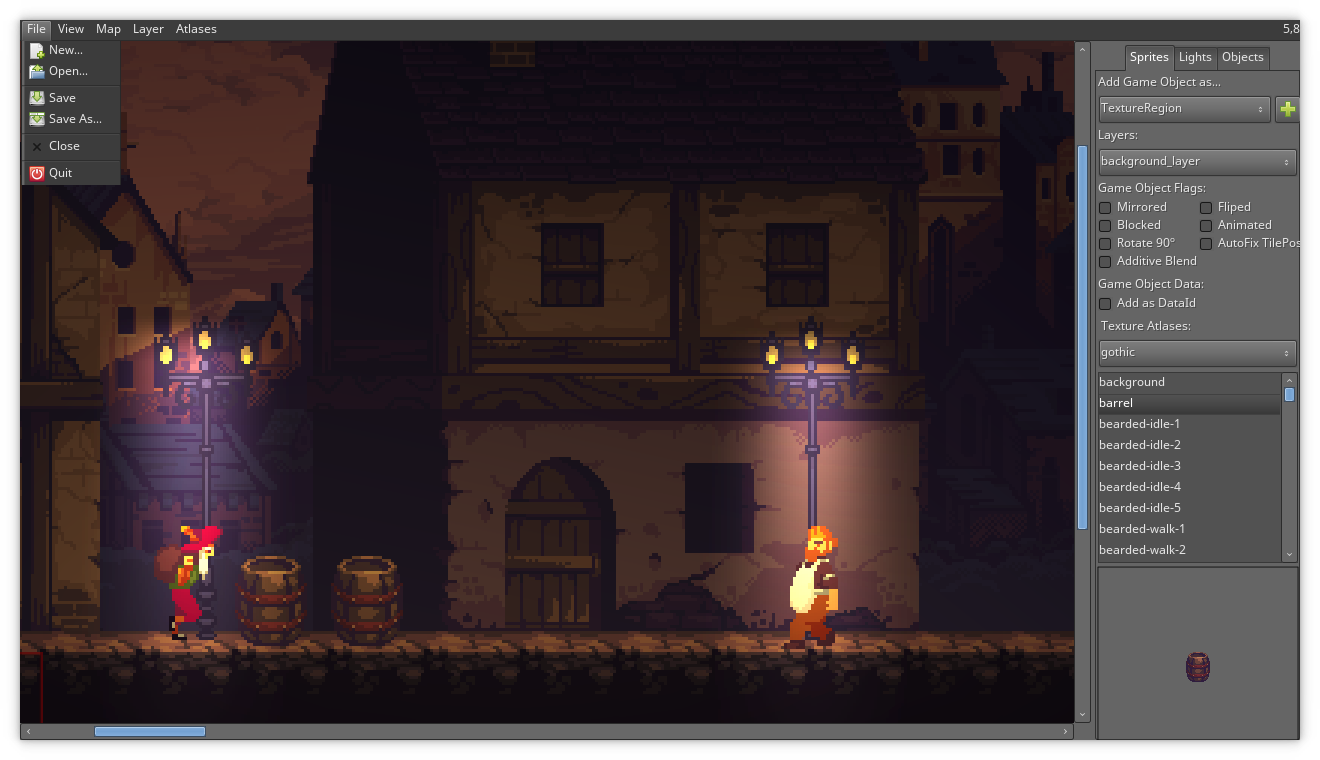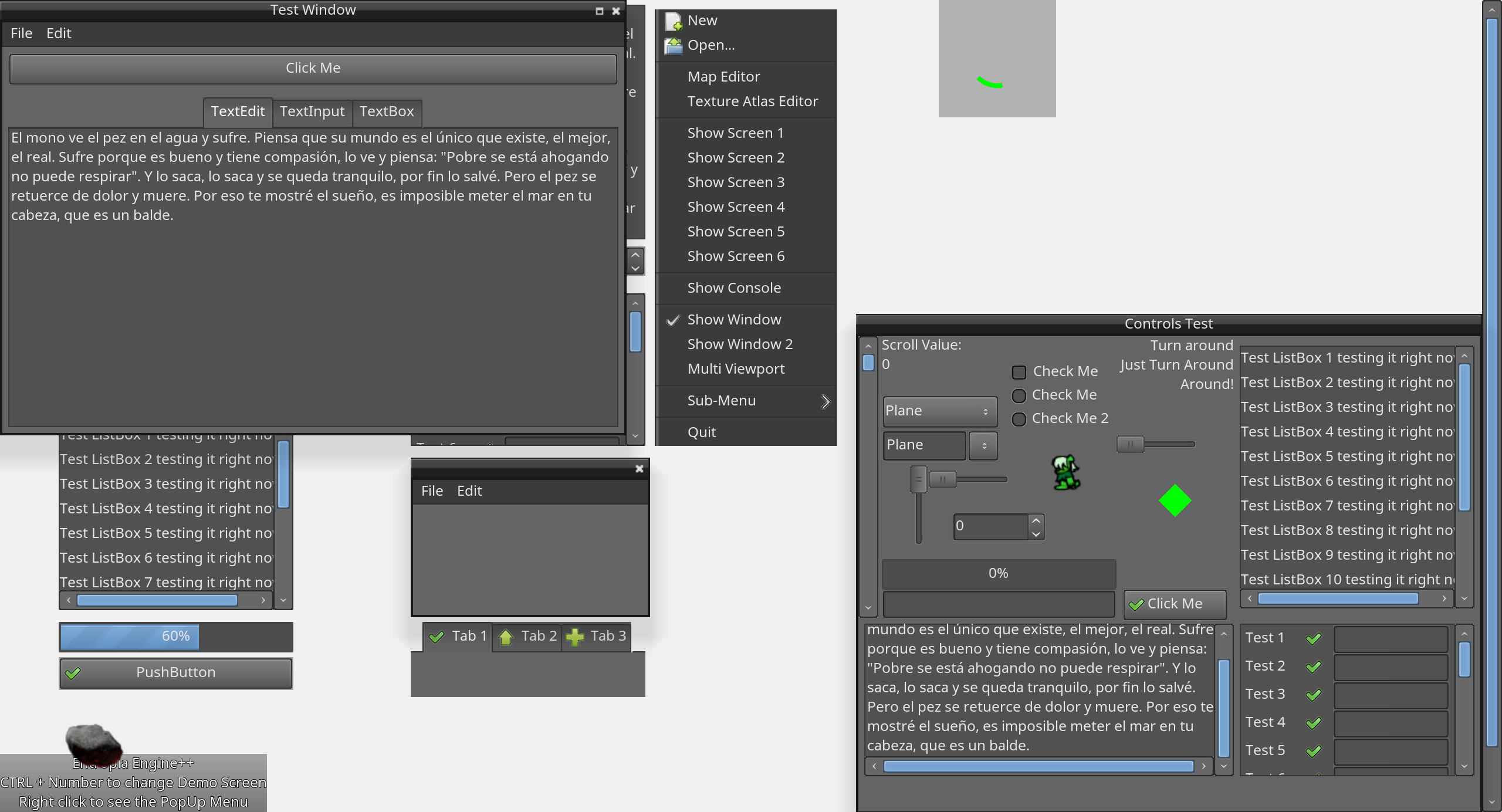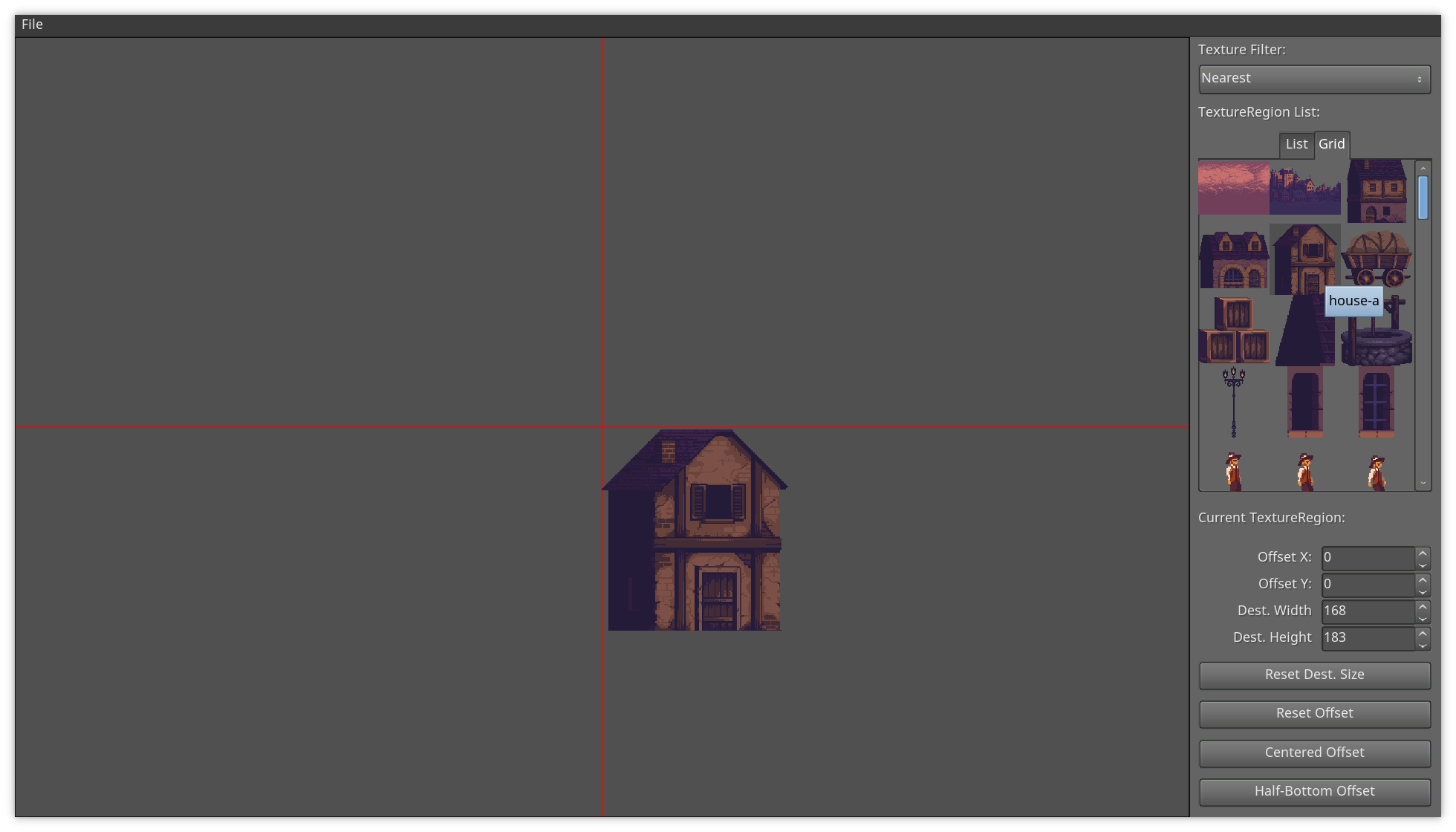Entropia Engine++ is a C++ 2D game engine/library designed for an easy cross-platform game development.
eepp provides:
-
Official support for Linux, Windows, Mac OS X, iOS and Android.
-
Exports to HTML5 using emscripten with some limitations.
-
It should work on FreeBSD, Solaris and Haiku.
-
Renderers for OpenGL 2 ( fixed-pipeline ), OpenGL 3 ( programmable-pipeline ), OpenGL ES 2, OpenGL ES 1, and OpenGL Core Profile.
-
Batch Renderer ( all the rendering is automatically batched by the engine ).
-
Full fonts support. True Type, BMFont and XNA Fonts.
-
Frame Buffer support.
-
Shaders support ( with automatic fixed pipeline shaders to programmable conversor ).
-
Vertex Buffer Object support.
-
Particle System.
-
Extendable Console.
-
Animated Sprites.
-
Texture Atlas support ( automatic creation and update of the texture atlas, editor included ).
-
Clipping Masks ( stencil, scissors, planes )
-
Nine Patch resizable bitmaps support.
-
Primitives drawables.
-
Many image formats supported ( included rasterized SVG ), compressed textures support ( direct upload to the GPU when possible ).
-
Backend based module, this means that you can easily create a backend for the window/input handling.
-
Currently supports SDL 2 as backend.
-
Clipboard support.
-
Hardware cursors.
-
Display Manager
-
Joystick support.
- OpenAL audio engine with extendable file format support. Read and write support for OGG and Wav, and read support for MP3 and FLAC. Audio module is based on an old version of the SFML Audio module.
- Full OOP chipmunk physics wrapper.
-
Provides all the basics stuffs for the full multi-threading support of the library, file formats support for packing, clocks, resource manager, translator, and much more.
-
Virtual File System class ( abstract assets providers into a single virtual file system, abstracting zip files and local file system into one for transparent load of resources, similar to PhysicsFS ).
-
Customizable Memory Manager. Used by default in debug mode to track memory leaks.
-
UTF8, UTF-16, UTF-32, Ansi, Wide Char support.
-
String class using UTF-32 chars internally.
-
Debug macros
-
General purpose functions and templates ( vector, quad, polygon, etc ).
-
Interpolation classes with easing.
-
Some minor math utilities, include Mersenne Twister random number generator implementation, perlin noise and more.
-
Web Requests with HTTP client, with TLS support ( provided by mbedtls or openssl ).
-
Asynchronous HTTP requests.
-
File Transfers with FTP client and FTPS client ( FTP with explicit TLS ).
-
TCP and UDP sockets.
-
HTTP Content-Encoding and Transfer-Encoding support.
-
HTTP Proxy Support.
-
HTTP Compressed response support.
-
Also HTTP resume/continue download support and automatic follow redirects.
Module was originally based on the SFML Network module implementation, though currently differs a lot from it.
-
Node based system for easy management of scenes.
-
Full control of node events ( clicks, mouse over, focus, etc ).
-
Event system.
-
Node Message system.
-
Programmable actions for nodes ( fade, rotate, move, scale, etc ).
-
Base controls to manage the game objects as nodes, with all basic input interaction events ( clicks, keypress, mouser over, focus, etc ).
-
Fully featured UI system, animation support, scaling, rotating, clipping, events, messages, etc.
-
Themes and skins support.
-
Pixel density support ( scaling of UI elements defined by the pixel density of the screen ).
-
All the basic controls are implemented ( button, textbox, combobox, inputbox, menu, listbox, scrollbars, etc ).
-
Draw invalidation support. It can be used to make real apps, with low resource usage ( only redraws when needed ).
-
Layout system similar to Android layouts ( LinearLayout, RelativeLayout, GridLayout ).
-
Advanced features as text selection and key bindings.
-
Load layouts from XMLs
-
Styling with CSS like format
-
Tiled Maps with software dynamic lights.
-
Full featured map editor.
-
Very simple UI Editor. Load layouts from an XML file and see the changes being made in real time.
-
Texture Atlas Editor. A very simple tool to allow the developer to create and edit texture atlases.
-
Map Editor: A advanced but simple map editor for the game engine. It lacks several features since I didn't have the time to work on it, this particular tool will probably die in favor of TMX map support in the near future ( but i'm not a fan of TMX maps, so there's no decision for the moment ).
- Support for multi-threaded resource loading ( textures, sounds, fonts, etc ).
It should look really familiar to any Android developer. This is a window with the most basic controls in a vertical linear layout display.
<window layout_width="300dp" layout_height="300dp" winflags="default|maximize">
<LinearLayout id="testlayout" orientation="vertical" layout_width="match_parent" layout_height="match_parent" layout_margin="8dp">
<TextView text="Hello World!" gravity="center" layout_gravity="center_horizontal" layout_width="match_parent" layout_height="wrap_content" backgroundColor="black" />
<PushButton text="OK!" textSize="16dp" icon="ok" gravity="center" layout_gravity="center_horizontal" layout_width="match_parent" layout_height="wrap_content" />
<Image src="thecircle" layout_width="match_parent" layout_height="32dp" flags="clip" />
<Sprite src="gn" />
<TextInput text="test" layout_width="match_parent" layout_height="wrap_content" />
<DropDownList layout_width="match_parent" layout_height="wrap_content" selectedIndex="0">
<item>Test Item</item>
<item>@string/test_item</item>
</DropDownList>
<ListBox layout_width="match_parent" layout_height="match_parent" layout_weight="1">
<item>Hello!</item>
<item>World!</item>
</ListBox>
</LinearLayout>
</window>How does it look with real code?
UITextView::New()->setText( "Text on test 1" )
->setCharacterSize( 12 )
->setLayoutMargin( Rect( 10, 10, 10, 10 ) )
->setLayoutSizeRules( LayoutSizeRule::MatchParent, LayoutSizeRule::WrapContent )
->setParent( layout );Element styling can be done with a custom implementation of Cascading Style Sheets, most common CSS2 rules are available, plus several CSS3 rules (some examples: transitions, custom properties, media queries, @font-face at rule, :root element). Here is a small example on how the CSS looks like:
@font-face {
font-family: "OpenSans Regular";
src: url("https://raw.githubusercontent.com/SpartanJ/eepp/develop/bin/assets/fonts/OpenSans-Regular.ttf");
}
@import url("assets/layouts/imported.css") screen and (min-width: 800px);
:root {
--font-color: black;
--background-input-color: rgba(255, 255, 255, 0.7);
--border-color: black;
--border-width: 1dp;
}
.screen TextView {
color: var(--font-color);
}
.form {
background-image: @drawable/back;
background-repeat: no-repeat;
background-size: cover;
}
.form .form_inputs {
background-color: var(--non-existent, var(--background-input-color));
margin-left: 100dp;
margin-right: 100dp;
padding-top: 72dp;
padding-left: 57dp;
padding-right: 57dp;
padding-bottom: 115dp;
}
.screen TextView.input,
.screen TextInput.input {
font-family: AkzidenzGroteskBQ-Cnd;
layout-width: match_parent;
layout-height: 80dp;
border-color: var(--border-color);
border-width: var(--border-width);
color: var(--font-color);
padding-left: 40dp;
padding-right: 40dp;
margin-bottom: 32dp;
skin: none;
hint-font-family: AkzidenzGroteskBQ-Cnd;
hint-font-size: 46dp;
hint-color: #818285;
background-color: #FFFFFF00;
transition: all 0.125s;
}
.screen TextInput.input:focus {
background-color: #FFFFFF66;
border-color: #796500;
}
.screen TextInput.input:hover {
background-color: #FFFFFF66;
}
@media screen and (max-width: 1024px) {
.form .form_inputs {
background-color: red;
}
}Documentation is located here. I'm currently working
on improving it. About 50% of the project is currently documented so still needs
a lot of work. Please check the code examples located in src/examples and you
can also check out the test ( src/test ) and tools ( src/tools ).
I'm putting my efforts on improving the documentation on the UI module since
currently is the most important and complex module but lacks of proper
documentation. If you have any question you can contact me anytime.
The repository uses git submodules so you'll need to clone the repository and
its submodules, in order to achieve this easily you can simply clone with:
git clone --recurse-submodules https://github.com/SpartanJ/eepp.git
The library has very few external dependencies. Most of the time you will only need SDL2 and OpenAL libraries with the headers installed. Also premake4 or premake5 is needed to generate the Makefiles or project files to build the library. I will assume that you know what you are doing and skip the basics.
GNU/Linux
In a Ubuntu system it would be something like ( also you will need gcc and freetype, but it will be installed anyways ):
sudo apt-get install premake4 libsdl2-2.0-0 libsdl2-dev libopenal1 libopenal-dev
Clone the repository and on the repository root directory run:
premake4 gmake
Then just build the library:
cd make/linux
make
That's it. That will build the whole project.
Windows
You have two options: build with Visual Studio or with mingw.
To build with any of both options first you will need to build the project files
with premake4. Then add the
premake4.exe file to any of the executable paths defined in PATH ( or add one ).
For Visual Studio:
premake5.exe vs2019
or
premake4.exe vs2010
For mingw:
premake4.exe gmake
Then you will need the prebuild binaries and development libraries of SDL2 and openal-soft. Download the ones needed ( VS or mingw ).
Then the project files should be found in make/windows/. A solution (sln) for
Visual Studio or the corresponding Makefiles for mingw.
Having installed everything, you'll be able to build for Visual Studio as any
other project.
And for mingw just make the project with: mingw32-make or any equivalent.
macOS
You have two options to build the project: with XCode or with gcc/clang manually. To build with any of both options first you will also need to build the project files with premake4. Then you will need the prebuild binaries and development libraries of SDL2, OpenAL is included with the OS. Install the SDL2 framework and you should be able to build the project.
For a CLI build you can use the projects/osx/make.sh script, that generates
the Makefiles and builds the project, also fix the dylibs generated.
For XCode :
premake4 xcode4
And open the XCode project generated in make/osx/
Android
There's a gradle project in projects/android-project/. It will build the
library with all the dependencies included. Use the example project as a base
for your project. Notice that there's a eepp.mk project file that builds the
library. That can be used in you projects.
iOS
I've compiled the project for iOS many times in the past but there's not a
recent build of it, so it might fail. But you can get the scripts to build it in
projects/ios/. You'll need some inspiration to make this work, but i promise
that i'll work on make this easier in the near future.
emscripten
There's a script for building the emscripten project in
projects/emscripten/make.sh. That should be enough in GNU/Linux or macOS
( only tested this on Linux ).
The library has been being developed for several years, it suffered many changes since its beginnings, I'm making any changes that I find necessary to improve it, so the API is still not totally stable (but close to be). It's being used in several applications oriented to publicity campaigns mostly developed for Android devices and Windows PCs. I personally never had the time to use it to develop a complex game with the library ( several frustrated projects ), but I made several UI oriented games for clients. The current project focus is on the UI module. And I'll continue working putting my focus on this. The plan is to provide an alternative UI toolkit fully hardware accelerated similar to the Android toolkit but simpler ( as in easy to use ) and also oriented to desktop apps.
Audio and Network modules were based the modules in SFML with several important differences mentioned above. I like to use what's well done and fit my needs, but since I have my personal views on how to implement some things I prefer to take the code, to have full control over it. Also many ideas were/are taken from other projects. Some I can think about: cocos2d-x, raylib, Android SDK, libgdx, Godot, XNA, LÖVE, and many other projects.
If all this sounds interesting to you for some crazy reason, contact me and let me know if I can help you to get into the library, and may be if you want, you can contribute to it in the future. This project needs contributors more than anything else.
The current state of the library is decent. In terms of features should be in a similar position than the most used 2D game engines out there. But lacks of course of the support+community that you can get from Godot or cocos2d-x to mention a couple. The main idea of this library is to focus on a better general approach to develop heavily UI based apps/games than the other options, with cleaner code and implementation.
The main reason I developed the library is for fun and to learn new technologies. I love spending time working on the library, but I know there's probably no real reason to develop something like this with the immense number of similar alternatives.
Plans/ideas for the future:
Keep improving the UI system, adding new widgets and improving the CSS support. Simplify and improve the UI widgets skinning/theming support. Add CSS animations support. Improve/create documentation for the UI module. Add more examples and also some tools. Add Scripting support ( first i would like to stabilize the library, but i'm getting there ). Add 2D skeletal animations support ( probably Spine2D, shouldn't be much work to implement ). Probably deprecate the Maps module, since i will focus my efforts on the UI system.
Special thanks to:
-
Sean Barrett for stb_image and all the stb libraries.
-
Sam Latinga for Simple DirectMedia Layer.
-
Jonathan Dummer for the Simple OpenGL Image Library.
-
Laurent Gomila for SFML
-
Yuri Kobets for litehtml
-
Lewis Van Winkle for PlusCallback
-
Dieter Baron and Thomas Klausner for libbzip
-
Jean-loup Gailly and Mark Adler for zlib
-
Milan Ikits and Marcelo Magallon for GLEW
-
Mikko Mononen for nanosvg
-
Scott Lembcke for Chipmunk2D
-
Christophe Riccio for glm
-
Rich Geldreich for imageresampler and jpeg-compressor
-
Arseny Kapoulkine for pugixml
-
Jason Perkins for premake
-
Martín Lucas Golini ( me ) and all the several contributors for SOIL2 and efsw
-
kcat for openal-soft
-
The FreeType Project
-
And a lot more people!


